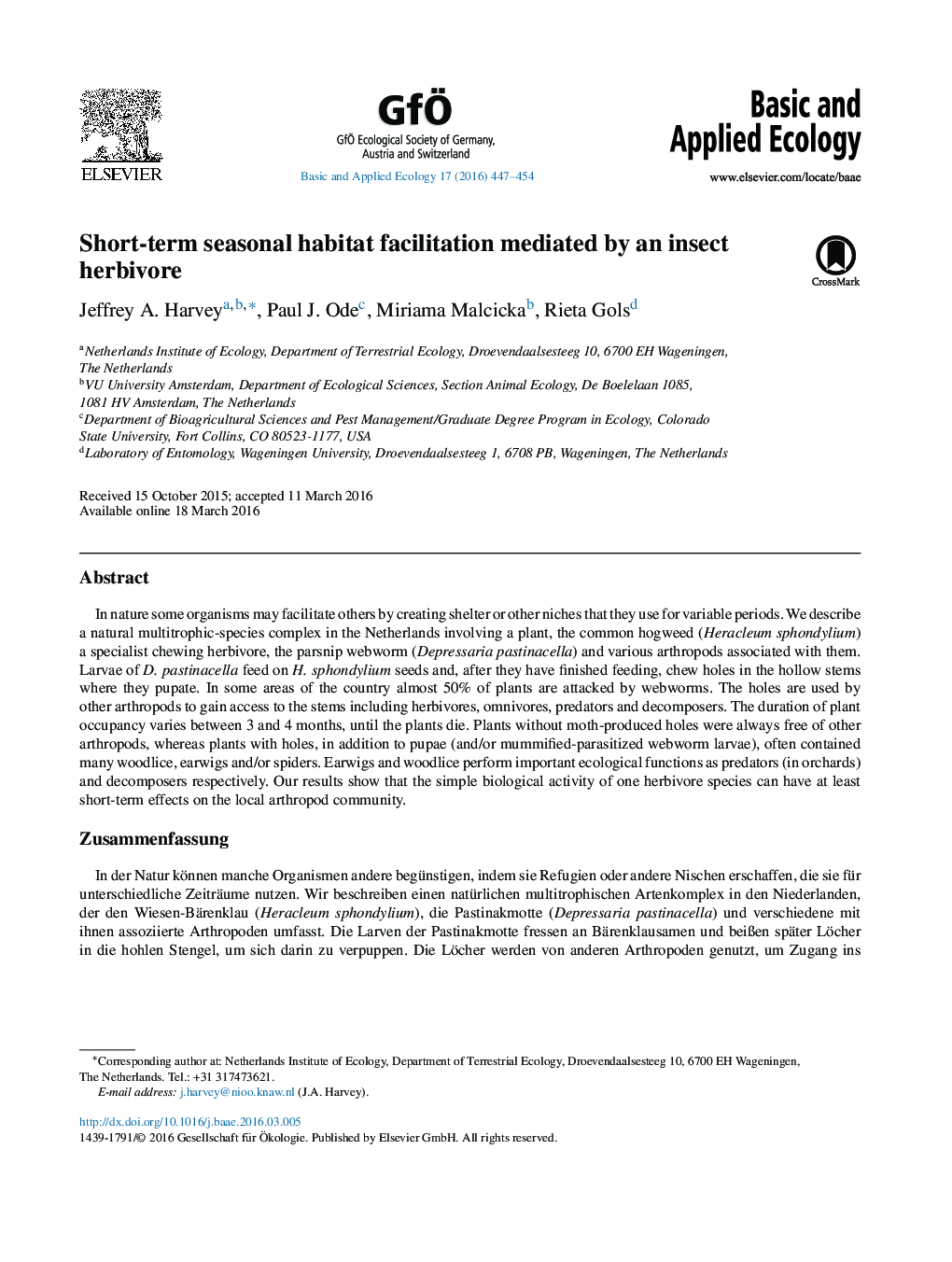| کد مقاله | کد نشریه | سال انتشار | مقاله انگلیسی | نسخه تمام متن |
|---|---|---|---|---|
| 4383843 | 1304369 | 2016 | 8 صفحه PDF | دانلود رایگان |
In nature some organisms may facilitate others by creating shelter or other niches that they use for variable periods. We describe a natural multitrophic-species complex in the Netherlands involving a plant, the common hogweed (Heracleum sphondylium) a specialist chewing herbivore, the parsnip webworm (Depressaria pastinacella) and various arthropods associated with them. Larvae of D. pastinacella feed on H. sphondylium seeds and, after they have finished feeding, chew holes in the hollow stems where they pupate. In some areas of the country almost 50% of plants are attacked by webworms. The holes are used by other arthropods to gain access to the stems including herbivores, omnivores, predators and decomposers. The duration of plant occupancy varies between 3 and 4 months, until the plants die. Plants without moth-produced holes were always free of other arthropods, whereas plants with holes, in addition to pupae (and/or mummified-parasitized webworm larvae), often contained many woodlice, earwigs and/or spiders. Earwigs and woodlice perform important ecological functions as predators (in orchards) and decomposers respectively. Our results show that the simple biological activity of one herbivore species can have at least short-term effects on the local arthropod community.
ZusammenfassungIn der Natur können manche Organismen andere begünstigen, indem sie Refugien oder andere Nischen erschaffen, die sie für unterschiedliche Zeiträume nutzen. Wir beschreiben einen natürlichen multitrophischen Artenkomplex in den Niederlanden, der den Wiesen-Bärenklau (Heracleum sphondylium), die Pastinakmotte (Depressaria pastinacella) und verschiedene mit ihnen assoziierte Arthropoden umfasst. Die Larven der Pastinakmotte fressen an Bärenklausamen und beißen später Löcher in die hohlen Stengel, um sich darin zu verpuppen. Die Löcher werden von anderen Arthropoden genutzt, um Zugang ins Stengelinnere zu erhalten. Die Pflanze wird für etwa drei bis vier Monate besiedelt bis sie abstirbt. Pflanzen ohne Mottenlöcher wurden niemals von anderen Arthropoden besiedelt, während Stengel mit Löchern zusätzlich zu den Mottenpuppen bzw. parasitierten Larvenmumien häufig viele Asseln, Ohrwürmer und/oder Spinnen enthielten. Ohrwürmer und Asseln erfüllen wichtige ökologische Funktionen als Räuber in Obstplantagen bzw. als Zersetzer. Unsere Ergebnisse zeigen, dass die einfache biologische Aktivität einer Herbivorenart zumindest kurzfristige Auswirkungen auf die lokale Arthropodengemeinschaft haben kann.
Journal: Basic and Applied Ecology - Volume 17, Issue 5, August 2016, Pages 447–454
